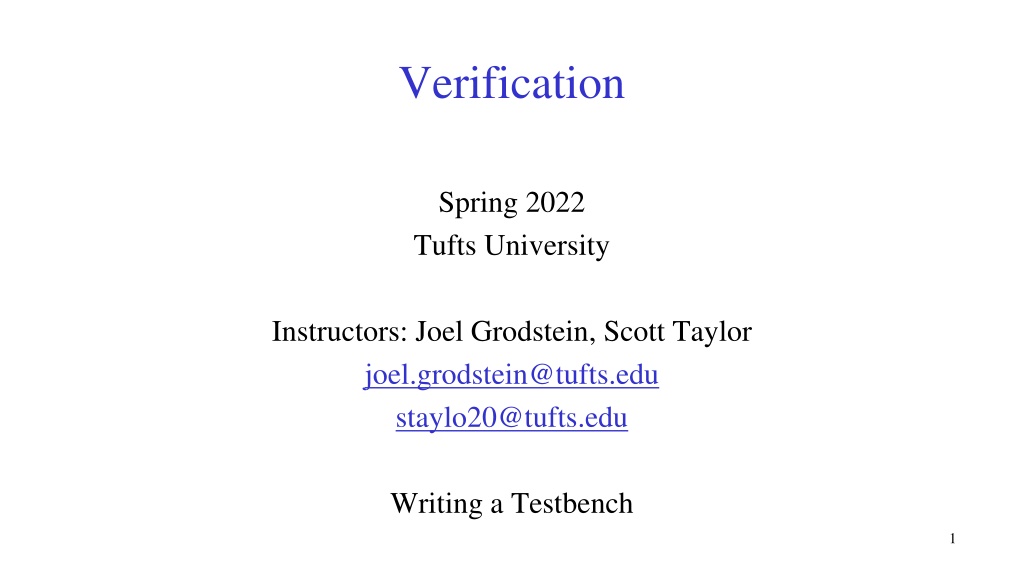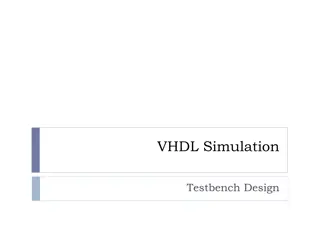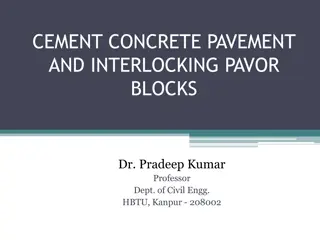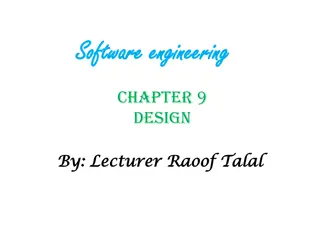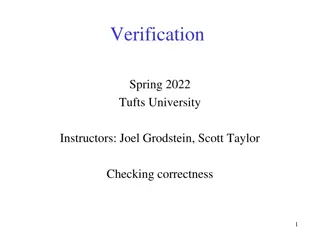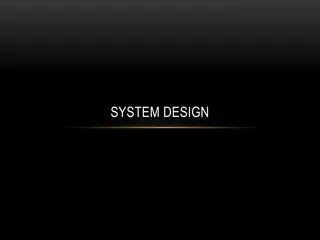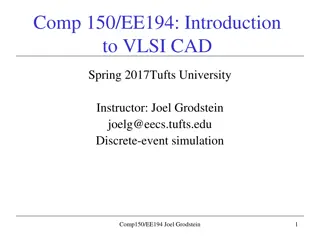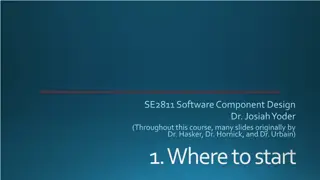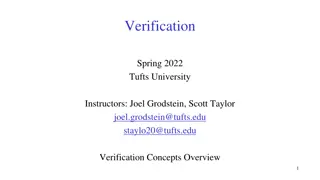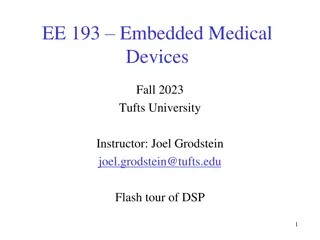Testbench Design at Tufts University
This collection of lectures by Joel Grodstein and Scott Taylor at Tufts University delves into the fundamentals and importance of testbench design in the realm of verification. Discover the key components of a testbench, its architecture, and the significance of treating testbenches as software systems. Learn how to create robust, maintainable, and scalable testbenches to enhance reusability across projects. Explore case studies and practical insights into designing testbenches effectively for various projects.
Uploaded on Feb 16, 2025 | 0 Views
Download Presentation

Please find below an Image/Link to download the presentation.
The content on the website is provided AS IS for your information and personal use only. It may not be sold, licensed, or shared on other websites without obtaining consent from the author.If you encounter any issues during the download, it is possible that the publisher has removed the file from their server.
You are allowed to download the files provided on this website for personal or commercial use, subject to the condition that they are used lawfully. All files are the property of their respective owners.
The content on the website is provided AS IS for your information and personal use only. It may not be sold, licensed, or shared on other websites without obtaining consent from the author.
E N D
Presentation Transcript
Verification Spring 2022 Tufts University Instructors: Joel Grodstein, Scott Taylor joel.grodstein@tufts.edu staylo20@tufts.edu Writing a Testbench 1
Whats in this lecture What is a testbench? Parts of a testbench Testbench Architecture Sharing components between testbenches Verification Joel Grodstein 2
What is a testbench? Device Under Test = DUT Testbench (TB) = anything that s not the DUT Poll: how much code is in the TB vs. the DUT? .33x, .5x, 1x, 2x, 3x, 4x Verification Joel Grodstein 3
Testbench design is not HW engineering!!! Testbenches are SOFTWARE. They should be approached like any complicated software system, and must be carefully architected to ensure they are Robust, maintainable Scalable, extendable Why? So we can reuse them on the next (slightly different) project or buy them as IP HW designers usually suck at creating testbenches. Even verification engineers often don t have sufficient SW engineering skills (more object oriented stuff!) Verification 4 Joel Grodstein/Scott Taylor
What is a testbench? What s in the TB, anyway? our FIFO TB had code to drive inputs, assertion-check outputs and the reference model FIFO DUT drive inputs scoreboard FIFO Ref model Verification Joel Grodstein 5
Ref model Verification 6 Joel Grodstein/Scott Taylor
logic [FIFO_WIDTH-1:0] flops [n_flops-1:0] always_ff @(posedge clk) begin if (wr_en==1) begin for (int i=1; i<n_flops; ++i) flops[i] <= flops[i-1]; flops[0] <= wr_data; end if (reset) n_items <= 0; if (!reset && wr_en && !rd_en) n_items <= n_items + 1; if (!reset && rd_en && !wr_en) n_items <= n_items-1; end always_comb begin if ((n_items>0) && (n_items<=n_flops)) rm_rd_data=flops[n_items-1]; else rm_rd_data = 'X; rm_full = (n_items==n_flops-1); rm_empty = (n_items==0); end Our FIFO ref model How much code, compared to the DUT FIFO? What would you change if packets were 16 bits wide, not 8? just FIFO_WIDTH What would you change if packets took two cycles, not one? nothing, or everything! could we write a more abstract FIFO ref model? Verification 7 Joel Grodstein/Scott Taylor
Discussion/breakout What would you do for a mesh reference model? Can you make it reasonably invariant to what a packet is? How closely should it model the actual mesh? Does it have to keep our vertical-first routing choice? Verification 8 Joel Grodstein/Scott Taylor
The same poll, again How much code is in the reference model vs. the DUT? about as much Poll: how much code is in the TB vs. the DUT? .33x, .5x, 1x, 2x, 3x, 4x Verification Joel Grodstein 9
Drivers, monitors, checkers (oh my) Verification 10 Joel Grodstein/Scott Taylor
Our FIFO stimulus repeat (10) begin wr_en = !fifo_full && ($urandom_range(1)==0); wr_data = get_data(); rd_en = !fifo_empty && ($urandom_range(1)==0); @(negedge clk); end The usual questions: What would change if our data were 8 bits, not 2? If it added parity? If our depth were 128 entries, not 4? If packets were two cycles, not one? If our FIFO internal implementation changed completely? Verification 11 Joel Grodstein/Scott Taylor
Stimulus + driver Our old model FIFO DUT drive inputs stimulus driver scoreboard FIFO Ref model high-level inputs unabstractor Verification 12 Joel Grodstein/Scott Taylor
Stimulus + driver FIFO DUT stimulus driver scoreboard FIFO Ref model Discussion what have we gained by this software sleight-of-hand? reuse the same stimulus for multiple projects can drive our DUT with multiple off-the-shelf stimulus generators the standard benefits of a layered system Has our layered system increased or decreased lines of code? Verification 13 Joel Grodstein/Scott Taylor
Stimulus + driver FIFO DUT stimulus driver scoreboard FIFO Ref model Has our layered system increased or decreased lines of code? Poll: how much code is in the TB vs. the DUT? .33x, .5x, 1x, 2x, 3x, 4x Verification 14 Joel Grodstein/Scott Taylor
More on Drivers Drivers: convert abstract transaction cycle-accurate signal drives Example: driver input = FIFO write command. Is it: WrEn=1 b1; data=4 b0110; @(posedge clk); data=4 b0110; @(posedge clk); WrEn=1 b1; @(posedge clk); A driver doesn t decide WHAT to drive! that s the job of the stimulus itself in both the above cases, the stimulus box just says write a 6 Verification 15 Joel Grodstein/Scott Taylor
Discussion Topics We said that a driver can also take an abstract transaction and drive it over multiple cycles. If you have multiple such drivers that overlap how do you prevent them from locking each other out or starving? Verification 16 Joel Grodstein/Scott Taylor
So, what creates the stimulus? There are several possibilities Directed tests. Specific hand-written tests to test a specific feature Pseudorandomtests. Random inputs (but typically not completely random more later) Fancy A stimulus component looks at the internal state of the machine and creates interesting command stimulus on the fly Verification 17 Joel Grodstein/Scott Taylor
Randomizing content Stimulus and configuration are all about randomization Randomizing (AND CONSTRAINING) choices is a lot of work Randomizing control registers to be consistent and legal Allowing illegal choices is important, but gets in the way of normal testcase operation It s harder than you think! Verification 18 Joel Grodstein/Scott Taylor
Our scoreboard is a simple checker Our FIFO scoreboard scoreboard_chk1: assert property (@(posedge clk) disable iff (reset) rm_rd_data === fifo_rd_data) else $strobe ("T=%0t: SB=%0x, DUT=%0x", $time, ); similar for full, empty In general, we use monitors and checkers to see if our test passed Verification 19 Joel Grodstein/Scott Taylor
Our model FIFO DUT monitors, scoreboard checkers stimulus driver FIFO Ref model Our scoreboard is just one way to check the test results Some ways don t even need a reference model (more later) Verification 20 Joel Grodstein/Scott Taylor
Layered architecture (again) high level FIFO DUT monitor checker monitors, checkers stimulus driver abstractor What are the advantages of this layering? reuse the checker across FIFOs with different low-level interfaces reuse the monitor across projects that check different things purchase one or the other as standard IPs Verification 21 Joel Grodstein/Scott Taylor
abstractor Potential architectures high level FIFO DUT monitor checker stimulus driver Remember the FIFO misunderstanding? Does RdEn mean you re taking the data now or you will take it next cycle? Which parts of this design should care about that choice? Verification 22 Joel Grodstein/Scott Taylor
Example #2 Read command to a cache Cycle 1: set valid=1 b1; cmd=1 b0; addr=64 h12345678 Cycle 2: nothing (cache is being accessed) Cycle 3: capture lower half of data (64 bits) Cycle 4: capture upper half of data (64 bits) and ECC status (success/fail) and ECC syndrome Monitor puts all this in a data structure one or more checkers determine if the value is correct perhaps they compare it to a reference cache Verification 23 Joel Grodstein/Scott Taylor
Potential architectures checker monitor FIFO DUT checker monitor stimulus driver checker Any advantages to adding complexity like this? A DUT may have more than one output interface (drives I2C for some signals and USB for others) Some checks are applicable to the information on either/both of the two interfaces Yes, we have multi-layered software with multiple APIs! Any examples of #_drivers #_monitors? Verification 24 Joel Grodstein/Scott Taylor
Why do we care about all this organization? There are many ways to accomplish our goals Why do we need to organize our testbench this way, specifically? 1. These are really standard software engineering practices compartmentalization, layers, reusability 2. The industry as a whole has moved to organizing verification code this way, pretty much regardless of the language(s) used 3. Did I mention REUSE? That is the biggest motivator! 1. Reuse within a project 2. Reuse between projects 3. Reuse between COMPANIES (IP reuse!) 4. Knowing these standards also helps you when you change jobs during your career Verification 25 Joel Grodstein/Scott Taylor
More reasons monitors checkers Monitors should only collect data. They don t decide correctness; leave that to the checkers/scoreboards! This is so that monitors can always be running regardless of the state of the checking environment What happens if you re deliberately trying to create an ECC error? You don t want the monitor flagging an error and terminating the simulation What if you want to disable a particular checker (perhaps it s coded incorrectly) but other checkers still want to consume the monitor info? Verification Joel Grodstein/Scott Taylor 26
More on Monitors MONITORS ARE NOT CHECKERS MONITORS ARE NOT CHECKERS MONITORS ARE NOT CHECKERS Monitors convert a cycle-accurate sequence of signals into an abstract idea of a transaction That data object is sent to checkers to decide whether the extracted result is correct or not Verification 27 Joel Grodstein/Scott Taylor
Discussion Topics We talked about drivers driving signals and monitors monitoring them. When might it make sense to monitor the same signals that you re driving? We said that, when a monitor abstracts the signals it s monitoring, it may abstract several cycles of data into one transaction, which might require looking across an entire pipeline to get data. How might you code this type of monitor? Verification 28 Joel Grodstein/Scott Taylor
Discussion Topics What if a monitor is looking at an interface and sees an error (e.g., parity error) Very simple for it to flag and error Pros and cons of having the monitor flag the error directly vs. having a checker(s) flag it assertion in the RTL Verification 29 Joel Grodstein/Scott Taylor
Coverage Verification 30 Joel Grodstein/Scott Taylor
Coverage components RTL coverage (line, condition, toggle, assertion) is built into most modern simulators Functional coverage is specific to the design and has to be manually created by the verification engineer. Examples: Detect when the same address has been requested in back to back cycles Determine we have had all encodings of a command except for 0x111, which is an illegal encoding Detect that we have had all combinations of: [command = rd, wr] x [Each individual byte having a parity error] x [parity error signal flagged] Verification 31 Joel Grodstein/Scott Taylor
Coverage Testbench Stimulus coordinator File with stimulus File Reader Reference Model Stimulus Datastruct Response Datastruct Driver DUT RTL Monitor (Functional) Coverage Monitor Response Datastruct Verification 32 Joel Grodstein/Scott Taylor
Discussion Topics Why is coverage an important part of the verification effort? What does it buy you? What might it mean if your functional coverage is 100% and your code coverage is 60% Verification 33 Joel Grodstein/Scott Taylor
Errors and the ending the test Verification 34 Joel Grodstein/Scott Taylor
Some FIFO code if(wr_en && full == 1'b0) begin fifo_mem[wr_ptr[1:0]] <= wr_data; wr_ptr <= wr_ptr+1; end if(rd_en && empty == 1'b0) rd_ptr <= rd_ptr+1; What if the FIFO is full and you try to both read and write? the write is ignored Is that good, bad or indifferent? Verification 35 Joel Grodstein/Scott Taylor
Some FIFO code if(wr_en && full == 1'b0) begin fifo_mem[wr_ptr[1:0]] <= wr_data; wr_ptr++; end if(rd_en && empty == 1'b0) rd_ptr++; What if the FIFO is empty and you try to read? the read is ignored Is that good, bad or indifferent? Let s rephrase that as the read is silently ignored the test will probably fail some time later Is that good, bad or indifferent? Verification 36 Joel Grodstein/Scott Taylor
Checkers and phases of execution Run-time Checks Some checks can detect a problem at any point of the simulation You want to detect errors as SOON AS POSSIBLE to save simtime and reduce debug effort You want to detect errors as SOON AS POSSIBLE AS SOON AS POSSIBLE. R E A L R E A L L L Y. Y. Who wants to debug a million cycle test when the failure happened 10% of the way through but wasn t fatal ? Remember, 40% of your time is spent debugging failures Verification 37 Joel Grodstein/Scott Taylor
Except when Any times when you wouldn t want to report an error immediately? What about a test of HW error response? Create a parity error & see if the HW calls the correct error handler How do you tell your checkers to PASS only if they see an error? Need multiple modes under SW control Verification 38 Joel Grodstein/Scott Taylor
Error Injection If you want to inject a parity error, how does the testbench do that? At a given cycle, read current parity Invert it Force the inverted value onto the wire Watch the chaos unfold Your TB must have this capacity! Do you corrupt the DATA instead of the PARITY bit?? Discuss pros and cons Again, your TB must be able to force errors in all useful ways Yet again, more code Verification 39 Joel Grodstein/Scott Taylor
Logfiles and debuggability What info is needed to debug a testcase? Testbench components can print very useful logs But what do you print? And how much? Tradeoff between verbosity and information overload Too little info and you can t debug Too much info and you can t find what you re looking for (Bad SNR Signal to Noise Ratio) Need the print messages, and a facility to control verbosity Still more code If the design has 10 subunits, should you be able to control verbosity individually? Verification Joel Grodstein/Scott Taylor 40
Ending the simulation forever begin #10; clk = ~clk; end initial begin : tester repeat (10) begin // Write(read) occasionally when not full(empty). @(negedge clk); end $stop; end The clock block runs until somebody decides the test is done Who does that, and how they know? For the FIFO? For the mesh? What about a cache that has a read miss? Verification 41 Joel Grodstein/Scott Taylor
Cleanup End-of-test checks Final memory content checks Print testcase statistics (cycles, bandwidth, event counts, ) can only be run at the end of the simulation; SV gives us a hook for this Post-processing Parse logfiles, analyze statistics from 100 tests Can t be done during simulation May use external databases Verification 42 Joel Grodstein/Scott Taylor
Clocks and reset Verification 43 Joel Grodstein/Scott Taylor
Handling clocks Clocks can have a significant impact on functional behavior Slow vs fast clocks affect sim performance Clock ratios between asynchronous units Clock gating logic for power reduction Changing clock speeds during operation Some clocks (usually low-freq) come from off-chip (e.g. Oscillator crystals) High-speed clocks are usually manufactured on-chip PLL (Phase Locked Loop) Verification 44 Joel Grodstein/Scott Taylor
Clocks How do we handle clocks? Choosing frequency ranges Choosing ratios between clock domains What s legal? What s allowable? What s preferred? What is most efficient? What is fastest? What finds interesting bugs? These factors are rarely aligned! How do we generate the clocks Usually, even for on-chip clock generation, the testbench creates the clock Avoid modeling analog clock behaviors But what about glitches? Duty cycles? Ramp rates? Verification 45 Joel Grodstein/Scott Taylor
Handling Reset Resets are also complicated to model and control Boot-time reset sequencing is often carefully defined/controlled and requires careful programming/modeling What about error-related resets? How do you model surprise resets (user hits the reset button)? What about resets due to power management events (C7 exit)? How do checkers react to resets? What if you re in the middle of a transaction? Hardware gets reset, but your scoreboard may be expecting a transaction to complete Verification 46 Joel Grodstein/Scott Taylor
Discussion Topics What do you have to consider in the testbench architecture if you yank a reset in the middle of your testcase? Verification 47 Joel Grodstein/Scott Taylor
Reuse Verification 48 Joel Grodstein/Scott Taylor
Multiple components, multiple testbenches! We ve talked about the hierarchy of testbenches Unit larger unit major IP SOC Different TB for each What components might you reuse? Stimulus, driver, checkers, coverage? What happens if a checker at the lowest level is usable at a higher level of integration? Just because it CAN doesn t mean it SHOULD Discuss: What are some reasons that you might NOT want a checker to be used at a higher level model? But if it SHOULD, how do you do that? Verification 49 Joel Grodstein/Scott Taylor
Our FIFO checker again FIFO TB may have a checker: read when empty scream or may be an assertion inside the FIFO RTL Do you keep this checker in the mesh TB? In the mesh-plus-cores TB? Data points: how slow is the checker? how likely is a test to fail on its own without the checker? Practical answer: keep all lower-level checkers for paranoia, until the TB runs unreasonably slow You need a mechanism to reuse/not checkers Still more code Can you reuse drivers? Verification Joel Grodstein/Scott Taylor 50
